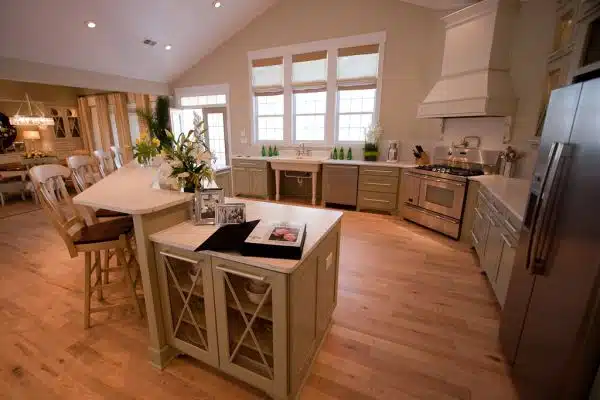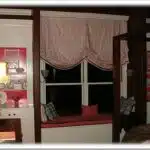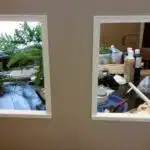Roman shades are a popular window treatment that adds both style and functionality to any room. They are a great alternative to traditional curtains or blinds, as they offer a sleek and modern look while still providing privacy and light control. However, purchasing custom-made Roman shades can be expensive. Luckily, with some basic sewing skills and a little bit of patience, it is possible to make your own DIY Roman shades at home.
In this article, we will provide you with step-by-step instructions on how to make your own Roman shades from scratch. We will cover everything from measuring your windows and choosing the right fabric to constructing the shade itself and adding finishing touches. Not only will making your own Roman shades save you money, but it also allows for customization to perfectly match your decor style. It’s an easy and fun DIY project that anyone can do with the right tools and materials. So, let’s get started!
Understanding The Different Types Of Roman Shades
Roman shades are an elegant window covering that has been around for centuries. There are two main types of roman shades: flat and hobbled. Flat roman shades have a sleek and modern appearance, while hobbled roman shades have a more traditional look with cascading folds. The choice between the two types depends on the style of your space and personal preference.
Another consideration when choosing roman shades is whether to go for a relaxed or classic style. Relaxed roman shades have a soft, billowy appearance when open, while classic roman shades maintain their flatness even when raised. Deciding between these styles depends on the level of formality you want to achieve in your space.
Choosing the right style of roman shade is important to ensure it complements the decor of your room. For a modern space, flat and relaxed styles work well, while for a more traditional room, hobbled and classic styles are ideal. By understanding the different types of roman shades available, you can make an informed decision about which style best suits your needs and preferences. In the next section, we will discuss how to choose the right fabric for your chosen style of roman shade.
Choosing The Right Fabric For Your Shades
Understanding the Different Types of Roman Shades has laid the foundation for creating your own DIY Roman shades. Now, it’s time to choose the right fabric for your shades. This step is crucial as the fabric selection will affect the final look and durability of your project.
When choosing a fabric, consider factors such as color coordination with your room’s existing decor, natural light exposure, and level of privacy needed. Here are three tips to keep in mind when selecting fabric for your DIY Roman shades:
- Choose a durable and high-quality fabric to ensure longevity.
- Consider the weight and thickness of the fabric – heavier fabrics may block out more light but can be more difficult to work with during installation.
- Think about the texture and pattern of the fabric – solid colors or subtle patterns can give a sophisticated look while bold prints can add a pop of personality to your space.
Fabric selection is just one aspect of creating DIY Roman shades that will enhance your space beautifully while serving functionality. Next up, we’ll dive into measuring your windows for custom fit so you can take accurate measurements before diving into sewing and assembly.
Measuring Your Windows For Custom Fit
Before starting the DIY Roman shade project, it is crucial to measure your windows accurately. Measuring tips are recommended to get precise measurements that will ensure that the shades fit perfectly. First, use a metal tape measure rather than a flexible one to avoid any errors. Next, measure both the width and height of your window frame in three different spots: top, middle, and bottom. Record the smallest of each measurement as this will be the final measurement.
Common mistakes when measuring windows include measuring only one part of the window instead of all three parts or using a cloth tape measure which can stretch and lead to inaccurate measurements. It is also important to consider whether you want an inside mount or outside mount for your shades. Inside mounts are installed within the window frame while outside mounts are mounted on the wall surrounding the window frame.
Now that you have accurate measurements of your windows, it’s time to calculate how much fabric you’ll need for each shade. Make sure to double-check your measurements before proceeding. Calculating the amount of fabric needed will depend on factors such as how many folds you want in your shades and whether you’re using an inside or outside mount. With accurate measurements in hand, calculating fabric needs should be simple!
Calculating The Amount Of Fabric Needed
Did you know that the average American household spends around $1,200 on window treatments? With DIY Roman shades, you can save some of that money and create a stylish and functional window covering. However, before you begin sewing your shades, it’s important to calculate how much fabric you’ll need.
When it comes to fabric options for Roman shades, there are plenty to choose from. You can use anything from lightweight cotton to heavy drapery fabrics. Keep in mind that the weight of the fabric will affect how well the shade stays in place when raised or lowered. Additionally, if you want a shade that lets in some light but still provides privacy, consider using a sheer or semi-sheer fabric.
Once you’ve decided on your fabric type and style, it’s time to plan your budget. The amount of fabric needed will depend on the size of your window and the number of folds in your shade. Be sure to measure carefully and add extra yardage for hemming and seaming. Don’t forget to factor in any additional materials you’ll need such as cord or dowels. By taking the time to plan out your project and budget accordingly, you’ll be able to create beautiful Roman shades without breaking the bank.
As important as calculating the amount of fabric needed is choosing a workspace where you can focus on creating your Roman shades with ease. Before starting your project make sure all tools are within reach so as not to lose momentum while working on it; additionally ensure ample space is provided for cutting cloth or other materials without distractions from other areas around such as noise or movement by people walking back-and-forth nearby which could cause damage if not careful enough during preparation stage!
Preparing Your Workspace
Gathering the necessary supplies is the first step in creating DIY Roman shades. Items such as fabric, lining, dowel, and cords should be collected prior to starting the project. Measuring the window is the next step, as the fabric must be cut to the correct size. Using a measuring tape, take two measurements of the window frame, one across the top and one across the bottom. This will give an accurate measurement of the size of fabric needed for the project.
Gathering Supplies
To begin your DIY Roman shades project, it’s important to gather all the necessary supplies. When deciding whether to take on this project yourself or hire a professional, consider your budget and desired outcome. While hiring a professional may provide a more polished look, DIY options can be much more budget-friendly.
To start, you’ll need fabric of your choice, lining material, fusible interfacing, and cord or ribbon for hanging. You’ll also need a sewing machine and basic sewing supplies like thread, scissors, and pins. If you’re looking for budget-friendly alternatives, consider repurposing old sheets or curtains for the fabric and using twine instead of ribbon.
Once you have all your supplies gathered, set up your workspace with plenty of lighting and room to spread out your materials. This will help ensure that you can work efficiently and accurately. With everything in place, you’re ready to begin creating beautiful Roman shades that will add both style and function to any room in your home.
Measuring The Window
Now that you have gathered your supplies and set up your workspace, it’s time to measure the window. Measuring accurately is crucial for creating functional Roman shades that fit perfectly. One of the most common mistakes people make when measuring is not accounting for the depth of the window frame or molding. This can result in shades that don’t hang properly or leave gaps where light can come through.
To avoid these issues, use a tape measure to determine the width and height of the window opening, including any molding or frames. It’s also important to consider how much overlap you want on each side of the window when calculating fabric size. If you’re unsure, it’s always better to err on the side of caution and give yourself a little extra fabric to work with.
While professional installation may include more precise measurements and techniques, taking accurate measurements yourself can save you money and allow for more customization options. With careful attention to detail, you’ll be able to create beautiful Roman shades that enhance both the look and function of your space.
Cutting The Fabric To Size
Fabric selection is crucial when making DIY Roman shades. Choose a durable fabric that will stand the test of time, and one that complements your room’s decor. The most common fabrics used for Roman shades are linen, cotton, and polyester blends. You can also choose from a variety of patterns and colors to add an extra touch of style to your shades.
When cutting the fabric to size, precision is key. Measure the windows where you want to hang the shades and add an inch on each side for seam allowance. Use a straight edge and a rotary cutter or sharp scissors to cut the fabric as accurately as possible. Keep in mind that if you have multiple windows, each may require slightly different measurements due to variations in window size.
Cutting techniques can vary depending on the type of fabric you choose. For example, if you select a lightweight fabric such as linen, use weights or pins to keep it in place while cutting. If your chosen material has a pattern, make sure to align it correctly before cutting so that it appears seamless when finished. Take your time with this step and double-check all measurements before proceeding to ensure that your Roman shades turn out perfectly.
With the fabric cut to size, it’s time to move on to preparing the lining material. This step is essential for blocking out light and providing insulation for your home. By using blackout lining fabric or thermal lining material, you can create a more energy-efficient living space while still enjoying beautiful Roman shades on your windows.
Preparing The Lining Material
After cutting the fabric to size, the next step in making DIY roman shades is to prepare the lining material. Lining material is crucial for providing privacy and insulation, as well as giving the shades a professional look. There are several lining options available, including blackout lining, thermal lining, and cotton sateen lining.
When choosing a lining material, consider your desired level of light control and insulation. Blackout lining blocks out all light and provides excellent insulation, while thermal lining helps regulate temperature and reduces energy costs. Cotton sateen lining is a lightweight option that adds a polished finish to your shades. Once you have chosen your preferred type of lining material, use cutting tools like scissors or rotary cutters to cut it to the same size as your fabric.
With the fabric and lining material cut to size, it’s time to move on to hemming the edges. Hemming ensures that the edges are neat and tidy while also preventing fraying over time. Depending on your sewing skills and preferences, you can choose from several hemming techniques such as double-folded hems or bias binding tape. With these steps complete, you are now ready to move on to attaching rings and cords before finally hanging up your newly made DIY roman shades.
Hemming The Edges
Accurately measuring the fabric for DIY roman shades is essential for creating a professional look. Sewing the edges of the fabric can be done with a standard sewing machine or by hand. Once the edges are sewn, attaching the cords to the fabric is necessary to provide tension and structure. The cords should be placed in the hemmed edge and reinforced with a bar tack for a secure fit. It is important to leave some slack in the cords to allow for the shade to be raised and lowered. Adding a decorative trim to the edge of the fabric can also be done after attaching the cords.
Measuring Fabric
When it comes to making your own roman shades, measuring the fabric is an essential step. There are different types of fabric that you can choose from such as cotton, linen, and polyester. You should consider the type of fabric that will work best for your space and the level of privacy and light control you require.
Measuring tips are crucial to ensure that you have enough fabric for your roman shade. You need to measure both the width and length of your window, taking into account any additional measurements for hemming and seam allowances. It’s important to be precise when measuring as small mistakes can result in a poorly fitted shade.
When measuring the fabric for your DIY roman shades, it’s helpful to create a checklist of all the measurements you need before heading out to buy materials. Take into consideration any pattern matching or directional prints if necessary. By following these measuring tips, you’ll be able to create a custom-fitted roman shade that meets your needs while adding style to your home decor.
Sewing Edges
Moving on to the next step in making your own roman shades, we’ll be discussing finishing techniques for hemming the edges. Hemming is an essential part of creating a neat and polished look for your DIY window treatment. This process involves folding over and sewing the raw edge of the fabric to prevent fraying and provide a clean finish. There are various edging options available that can add a decorative touch to your roman shade, such as using contrasting thread or adding trim.
Before starting the hemming process, it’s important to decide on the type of edging you want to use for your roman shades. You can choose from simple folded hems, double-folded hems, or bias tape binding. Folded hems are suitable for lighter fabrics and can be easily done using a sewing machine or by hand. Double-folded hems provide more durability and strength but require more time and effort to create. Bias tape binding is an excellent option if you’re looking for a decorative edge that adds contrast or matches with other elements in your space.
When sewing the edges of your roman shade, make sure that you’re working with precise measurements and that all corners are neatly folded and stitched. Take time to press the fabric with an iron before sewing to ensure that it lays flat and doesn’t bunch up during stitching. Remember that hemming is not only about creating a functional edge but also about adding style and personality to your DIY project.
In conclusion, hemming the edges of your DIY roman shades is an essential step in creating a polished finish. By understanding different edging options and taking care when measuring and sewing, you can achieve a beautiful custom-fitted window treatment that complements your home decor. Don’t hesitate to experiment with different techniques and add unique details like trims or contrasting thread to make your roman shades truly one-of-a-kind!
Attaching Cords
Moving forward with the process of hemming the edges of your DIY roman shades, it’s important to consider attaching cords to make them functional. Cords are essential for raising and lowering the shades, and they can also add a decorative touch to your window treatment. However, tying knots and cord safety precautions are necessary considerations when attaching cords to your roman shades.
To attach cords, you’ll need to sew channels into the back of the shade where the cords will be inserted. These channels should be evenly spaced and run vertically from top to bottom. You can use a sewing machine or hand stitch these channels, depending on your preference. Once you have created these channels, thread the cords through them and tie knots at each end.
When attaching cords, it’s important to follow cord safety precautions. Make sure that all cords are out of reach of children and pets by securing them with cord cleats or tension devices. Avoid using looped cords as they pose a choking hazard. Consider using cordless options for added safety and convenience.
In conclusion, attaching cords is an important step in making functional roman shades. By sewing channels into the back of your shade and following cord safety precautions, you can create a safe and stylish window treatment that complements any room in your home.
Attaching The Lining Material
Once you have cut your fabric and lining material to the appropriate size, it is time to attach the lining. Before doing so, it is important to select a lining material that will work best for your project. There are a variety of options available such as blackout lining, thermal lining, and standard cotton or polyester lining. Consider the level of light control and insulation you desire before making your selection.
Sewing techniques can vary depending on the type of lining material you choose. For example, if using blackout lining, it is recommended to sew with a longer stitch length to prevent needle holes from allowing light through. It is also important to ensure that the lining lays flat against the fabric without any puckering or wrinkling. Use pins or clips to hold layers in place while stitching.
Once you have attached the lining material to your fabric panels, trim any excess and press seams flat. Your roman shades are now ready for the next step: creating folds. But before we move on, here are some tips for attaching your lining:
- If using a lightweight fabric such as linen or silk, opt for a lightweight lining material as well.
- For extra insulation and energy efficiency, consider using thermal lining.
- When sewing with heavier materials such as velvet or denim, use a heavier weight thread and needle for added strength.
- Avoid stretching the fabric when attaching the lining to prevent distortion in shape or size.
With your chosen lining securely attached to your fabric panels, it’s time to create the folds that will give your roman shades their elegant look and functionality.
Creating The Folds For Your Roman Shades
After attaching the lining material, it’s time to move on to the next step in making your DIY Roman shades – creating the folds. This is where fabric manipulation comes into play. There are various folding techniques that you can choose from depending on the style and design you want to achieve. The most common folding technique is the classic knife pleat fold, which creates a neat and uniform look.
To create knife pleats, start by measuring and marking the spacing between each fold. Then, fold the fabric over itself at each mark, making sure that each pleat is of equal size. Secure each pleat with pins or clips and press them down with an iron for a crisp finish. If you want a more relaxed look, you can opt for a soft fold or a hobbled fold instead.
Fabric manipulation is a crucial part of making Roman shades as it gives them their signature look and functionality. With different folding techniques, you can create shades that are tailored to your preferences and needs. Once you’ve mastered this step, it’s time to move on to attaching the rings and cord which will allow you to raise and lower your shades effortlessly.
Attaching The Rings And Cord
Section Topic: Attaching the Rings and Cord
To complete your DIY Roman shades, you’ll need to attach the rings and cord. This step is crucial, as it ensures that your shades function properly. Before we dive into the details of attaching the rings and cord, let’s take a moment to appreciate how far you’ve come in this project. You’ve chosen the fabric, cut it to size, hemmed the edges, and installed the mounting board. Now, you’re ready to add the finishing touches.
Choosing cord: When it comes to choosing cord for your Roman shades, there are a few things to consider. First and foremost, make sure that you select a strong and durable cord that can handle the weight of your shade. Nylon or polyester cords are good options. Additionally, choose a cord that matches the color of your shade for a seamless look. Finally, consider purchasing extra cord so that you have some on hand in case you need to replace any down the line.
Sewing rings: The next step is to sew rings onto the back of your shade. These rings will hold the cords in place and allow you to raise and lower your shade smoothly. To do this, measure out where each ring should be placed along each fold of your shade (usually every 8-12 inches). Then, sew them onto the backside of your shade with strong thread. Be sure not to sew through all layers of fabric – just attach them securely on one layer.
Now that you’ve attached both rings and cords, you’re almost done! The next step is installing the shade hardware so that you can hang up your beautiful new Roman shades with pride.
Installing The Shade Hardware
Hardware options for your diy roman shades can vary depending on the look you want to achieve and the weight of your fabric. For a simple and modern look, opt for cordless shade hardware that uses tension to hold the shade in place. This option is great for lighter fabrics and provides a minimalist aesthetic. If you have heavier fabrics or want a more traditional look, consider using corded hardware with a pulley system. This will allow you to easily raise and lower your shades while providing extra support.
When it comes to installation tips, make sure to measure carefully before drilling any holes into your window frame. Use a level to ensure that your hardware is installed straight, as even a slight angle can cause your shades to hang unevenly. It’s also important to use the correct screws and anchors for your type of window frame – consult with a hardware store employee if you’re unsure which materials to use.
Proper installation of your shade hardware is crucial for the overall function and appearance of your diy roman shades. Take the time to research different options and follow best practices during installation to ensure that your shades are secure and functional for years to come.
Moving forward, hanging your diy roman shades is the next step in completing this project.
Hanging Your Diy Roman Shades
Once you have completed making your DIY Roman shades, it’s time to hang them up. There are different hanging techniques that you can choose from, depending on your preference and the type of window you have. One common way is to use a tension rod that fits snugly into the window frame. This method is great for smaller windows or those that don’t require frequent adjustments.
For larger windows or those with heavier shades, you may need to use brackets or screws to secure the hardware. When choosing the right hardware, consider the weight of your shades and ensure that the brackets or screws can support them without sagging or pulling away from the wall. It’s also important to measure carefully and ensure that your hardware is installed level and in line with each other.
Properly hanging your DIY Roman shades not only ensures their functionality but also adds an aesthetic touch to your space. With the right hardware and technique, you can showcase your beautiful creation while also enjoying its function as a window treatment. In the next section, we will explore how you can add decorative trim or accents to further elevate the look of your shades.
Adding Decorative Trim Or Accents
While your DIY roman shades will look stunning on their own, adding some decorative trim or accents can take them to the next level. You can choose from a variety of decorative trim ideas, like tassels, fringe, or ribbon. Adding trim is also an excellent way to personalize your roman shades and make them unique to your style.
If you’re looking for a more subtle accent option, consider adding some contrast piping or fabric-covered buttons to your shade’s edges. These small details can go a long way in elevating the look of your window treatment. Another idea is to stencil a design onto the shade using fabric paint for a custom touch.
When it comes to choosing DIY accent options, there are countless possibilities. You can use materials like lace or burlap to add texture or even add an embroidered monogram for a personal touch. Whatever option you choose, be sure it complements the overall style of your room and doesn’t detract from the beauty of your DIY roman shades.
As you put the finishing touches on your DIY roman shades with decorative trim or accents, keep in mind that regular cleaning and maintenance will help keep them looking their best for years to come. In the next section, we’ll explore tips and tricks for cleaning and maintaining your roman shades so that they stay looking as good as new.
Cleaning And Maintaining Your Roman Shades
Maintaining and cleaning your Roman shades can greatly prolong their lifespan. Here are some tips to keep them looking new and functioning well.
Firstly, it is important to regularly dust your shades with a soft brush or vacuum attachment. This will prevent any dirt or debris from settling into the fabric fibers. For more thorough cleaning, spot clean any stains with a mild detergent and warm water. Avoid using harsh chemicals or bleach as they may damage the fabric.
When it comes to cleaning different types of roman shade fabrics, there are specific solutions to use. For cotton and linen fabrics, a mixture of warm water and mild soap works best. Synthetic materials such as polyester can be cleaned with a solution of warm water and vinegar. Natural woven shades should only be vacuumed or dry cleaned by a professional.
By following these tips for maintaining and cleaning your Roman shades, you’ll be able to enjoy them for years to come while keeping them in good condition. Remember to always check manufacturer instructions before attempting any form of cleaning or maintenance on your shades.
Conclusion
In conclusion, making your own DIY Roman Shades is a great way to add a personal touch to your home decor while saving money. With the right fabric and hardware, you can create beautiful window treatments that will enhance the overall look of any room. Imagine walking into your living room and seeing the sunlight streaming through your custom-made shades, casting a warm glow on everything in sight. Or envision the cozy ambiance created by your new Roman Shades in your bedroom, providing privacy and blocking out unwanted light.
By following these easy steps and tips, you’ll be able to create the perfect Roman Shades for any space in your home. Whether you’re a beginner or an experienced DIYer, this project is sure to bring satisfaction and joy as you see your vision come to life. So roll up those sleeves, get out that measuring tape and let’s make some beautiful window treatments together!
Image Credits
- “Custom Roman Shades in the Kitchen” by DesignFolly.com (featured)





























